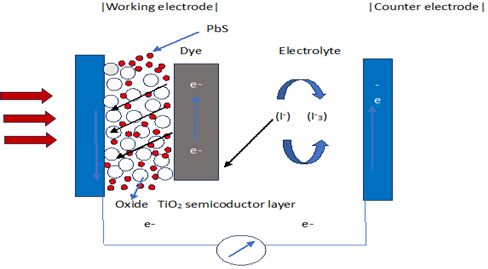Dye Sensitized Solar Cell with Immersion Time Variation of Working Electrode on Quantum Dot: A Performance Optimization Study
Keywords:
Dye-sensitized Solar Cells, TiO₂, Quantum Dot, EfficiencyAbstract
The growing demand for renewable and sustainable energy has spurred interest in dye-sensitized solar cells (DSSCs) as cost-effective alternatives to conventional silicon solar cells. However, their performance is often limited by narrow spectral absorption and dye instability. This study investigates the optimization of DSSC performance by incorporating lead sulfide (PbS) quantum dots (QDs) and natural hibiscus dye as a hybrid photo-sensitizer. QD-DSSC devices were fabricated using TiO₂-coated electrodes sensitized with hibiscus dye and 0.05 M PbS quantum dots at varying immersion times (6 h, 12 h, 24 h). The I–V characterization revealed that immersion time critically influenced device performance. The highest efficiency of 3.19 % was achieved at 12 hours of immersion, corresponding to the optimal balance of dye loading and PbS layer formation. The associated photovoltaic parameters were Isc = 7.965 mA, Voc = 0.72 V, and FF = 0.557, indicating improved electron transport and reduced recombination. In contrast, 6 h and 24 h immersion times yielded lower efficiencies of 2.01 % and 0.754 %, respectively, due to insufficient or excessive sensitizer deposition leading to poor charge mobility or increased recombination. Electrical performance analysis using a solar simulator and electrochemical impedance spectroscopy (EIS) confirmed that 12-hour immersion provided optimal interfacial charge transfer and minimized resistance. The study demonstrates that integrating PbS QDs with natural dyes broadens spectral absorption and enhances DSSC efficiency, with 12 hours identified as the optimal immersion duration for sensitizer application.

Published
How to Cite
Issue
Section
Copyright (c) 2025 Journal of Science Research and Reviews

This work is licensed under a Creative Commons Attribution-NonCommercial 4.0 International License.
- Attribution — You must give appropriate credit, provide a link to the license, and indicate if changes were made. You may do so in any reasonable manner, but not in any way that suggests the licensor endorses you or your use.
- NonCommercial — You may not use the material for commercial purposes.
- No additional restrictions — You may not apply legal terms or technological measures that legally restrict others from doing anything the license permits.




